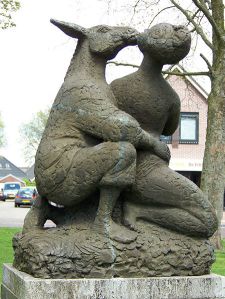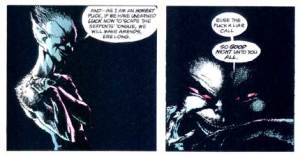by KV Taylor
The Books of Magic, a now-defunct DC-Vertigo comic series, sprouted from Neil Gaiman’s mystical miniseries of the same name, which I went on about at length in a previous post this month. The book on which I concentrated, Book III: The Land of Summer Twilight, details Timothy Hunter’s[1] journey with Dr. Occult through Faerie. It’s a particularly relevant book for the ongoing series (well, okay, they all are), and directly spawned the stories peopling The Books of Faerie: Auberon’s Tale and The Books of Faerie, still available in trade paperback collections[2].
In order to discuss these pretty little TPBs, I’m going to have to spoil Gaiman’s Books of Magic a touch. Not plot wise, but a single line from Titania that could be interpreted in several ways (imagine that!). It will by no means ruin your enjoyment of the GN if you pick it up, as it has zero bearing on the plot, but you’ve been warned.
While both collections consist of pure Books of Magic pre-history and side-plots, I’m sticking to the history stories — all of which were written by Bronwyn Carlton and drawn by Peter Gross (with Vince Locke in Auberon’s Tale). They amount to a kind of double fanfiction: stories based on Gaiman’s cryptic Titania from BoM, and stories based on a more directly Shakespearian concept of Oberon and Titania. The stories are bent to suit and explain the world of the ongoing BoM books, but stand alone as objects of interest to fae lovers.
I’ll start with Auberon’s Tale, to move chronologically — not in order of publication. It begins with Book I: The Regicide, in which King Magnus, a bit of a drunken idiot with a pureblood fairy superiority complex, insists that he compete in the tourney — against a lovable idiot of a troll. (Note that no one tries to stop him.) Obviously, this ends badly, and seeing as fairies don’t reproduce very often, the kingdom is left without an obvious heir. There is the king’s brother, Duke Huonnor, and there is the son of the king’s older sister, little Auberon. The king’s cousin Obrey and a courtier with a deeper connection to Magnus, Amadan, conspire to set Auberon on the throne as a puppet. You can see them talking in the shadows up there, as a matter of fact, in the doorway behind goofily grinning little Aubie, as his aunt and guardian Dymphna calls him.
Even before the sweet, liberal-minded boy can be installed, the machinations begin. Amadan tries to turn Obrey against Auberon, Auberon’s aunt Dymphna becomes engaged to Obrey, Huonnor goes to war with Obrey (who supposedly fights in Auberon’s name), and the whole thing becomes a sticky political mess worthy of the fae. As if it wasn’t enough, Amadan reveals that Magnus was trying to solve the fairy reproductive issue with what some consider less-than-savory experiments.
Anyone familiar with tales of the fae will guess that yes, humans are involved.
It’s a good read, and I think it highlights the slightly more human qualities of the fae here, as opposed to the frighteningly mercurial Gaiman Titania (though Auberon isn’t in BoM), and the sort of otherworldly yet simultaneously earthy fae Shakespeare envisioned. They certainly have the Shakespearean element of jealousy, though. Oh, and as a bonus, you get a really cute short about little Aubie meeting his friend, the magnificent little pink fotch he’s got on a leash on the cover up there.
Titania’s story, told in the collected The Books of Faerie TPB, begins with Book I: The Foundling’s Tale. There’s a sort of prologue, in which we see BoM frontman (frontboy?) Tim Hunter confronting a fully grown King Auberon and Queen Titania, claiming to be Titania’s son. Remember that thing I said about spoiling a single line of the Gaiman story? I said in my previous post on BoM that “…Titania’s parting words, for us alone, lead us to believe Tim will always be tied to Faerie in ways he can’t yet imagine.” Because what she said was, “And will you also hatch out worlds, my son?”
Take it how you like–and oh, Gaiman’s left it open–but Bronwyn Carlton’s backstory for Titania takes it literally. This goes one step beyond A Midsummer Night’s Dream‘s adopted Indian boy changeling, but it’s cool that the entire tale works as a nod to it, even as it fills in a gap in the BoM mythos. (The double fanfiction element strikes!)
The story really begins with a little girl called Maryrose being led into Faerie in spite of her gran’s warnings. The then-queen of Faerie, Dymphna, takes her under her wing and keeps her along with her little elf handmaidens, and treats her as a daughter. And then, King Obrey, whose machinations only seem to have gotten more ridiculous (oh yes, Lord Amadan is still there, if in a slightly, ah, altered form), comes home from war… and falls for little Maryrose, never knowing she was once mortal.
It’s a more character-driven story than Auberon’s, Maryrose’s journey from innocent to fae courtier, and what she’s willing to sacrifice to be a queen. Almost the moment she achieves this goal, Auberon finally defeats his cousin, Obrey the Usurper, and returns to Faerie to reclaim his crown… and offers Titania a deal, in the name of peace and prosperity for his people. She accepts, and yet, she’s never happy, caught between what she is and what she’s trying to be. Even Tamlin the Falconer can only make her happy for a short time, and that, well, as the above panel implies, spawns a mess.
Naturally it’s more complicated than all that, full of ins and outs and political madness, but that’s the gist. Titania’s tale has that same, slightly more human aspect, which . She’s at once strong and willing to sacrifice, but also swings to vulnerability and regret. Her main conflict stems from the continued emphasis on the importance of fairy blood, and her lack thereof. In that way, it’s this sort of typical fantasy story about queenship, womb control, and domestic complications. She’s not the Titania I expected, but she’s satisfying, if problematic, as a character, all the same.
The other stories in these collections, the side-plots from the ongoing series, are very cool too–and there’s another TPB collection called The Books of Faerie: Molly’s Story (which I’ve not been able to find, but are beyond the scope of this post, anyhow, as they feature the BoM ongoing character, Molly O’Reilly). I like the art; it’s expressive and easy on the eyes, though not perhaps as otherworldly as Charles Vess’s original Land of Summer Twilight work. The covers, reproduced as full-paged panels as with most TPB collections, are uniformly gorgeous.
[1] Boy with the potential to become the World’s Greatest Magician, hero of both Gaiman’s BoM and the ongoing comic book series, for those not playing along at home.
[2] Side note: these TPB Books of Faerie are how I discovered The Books of Magic in the first place. They were in the bargain bin at my local comic shop and I’m going, “Auberon?! I’m in!”
KV Taylor has been a staff member and contributor for Monster Awareness Month, Vampire Awareness Month, and Ghost Appreciation Month, and is very pleased to be on the job again with the fae. Her freaky Appalachian fae novel, Scripped, is forthcoming from Belfire Press this summer.








